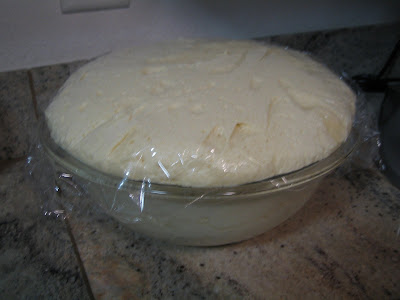Pastry cream is just one of the ingredients in Sweet Crepes with Peaches and Pastry Cream, but it requires some preparation that is detailed in the recipe for a strawberry tart. . That fact earns the pastry cream its own post.
It's a pretty simple concoction, consisting of only milk, sugar, vanilla bean, cornstarch, butter, Grand Marnier, and eggs. Take out just a couple of things and you essentially have an ice cream base. It's neat to see how similar recipes yield completely different foods.

I started out by combining some of the milk, some of the sugar, and the vanilla bean into a saucepan and bringing it all to a simmer.

While the milk mixture was coming to a simmer, I combined the rest of the milk and the cornstarch in a small bowl.

Now that the cornstarch was sitting around getting happy, I whisked the eggs and remaining sugar in a bowl, resulting in this anti-climatic mixture:

Even more anti-climatic-ly, I mixed the cornstarch mixture into the egg mixture, which I'm sure you can guess looked exactly like an egg mixture mixed with a milk mixture:

The milk had come to a simmer, so I tempered the egg mixture by pouring a bit of the hot milk mixture into the egg mixture. When I was convinced the egg mixture was sufficiently warm to avoid turning it all into scrambled eggs, I dumped the egg mixture into the saucepan of simmering milk:

I cooked the mixture over medium heat. Under caution from the book, I continuously stirred it waiting for the mixture to thicken and become "lumpy". It started to thicken at about the same time that my arm was beginning to get tired:
 My arm was numb around the time it started to become lumpy. It was like stirring some well-set cement:
My arm was numb around the time it started to become lumpy. It was like stirring some well-set cement:
That was it for the cooking portion. I took the cream off the heat and continue to whisk the crap out of it to remove all of the remaining lumps. After it had been off the heat for a couple of minutes, I added in the butter and Grand Marnier. Immediately after that I spread the cream out into a baking dish and covered it with plastic wrap. As far as I can tell, this is to avoid the formation of a skin on the top of cream. We all know the skin that forms on some foods when left out too long, and it's gross, so I had no intentions of dealing with it here:

Now that the cream was wrapped about four times tighter than it needed to be, it went into the refrigerator. I would use the cream in the crepe recipe the next night.
Without spilling the beans on the crepe recipe, I'll just say that the cream had pretty great flavor. The texture wasn't my favorite however. It wasn't really creamy, but more like a gel. It did something that resembled melting in the crepe, which helped, but it was still just an odd texture for me. It was the perfect complement taste-wise, balancing the lightness of the crepe and the peaches, and I don't think the crepes would of been the same without the cream.














